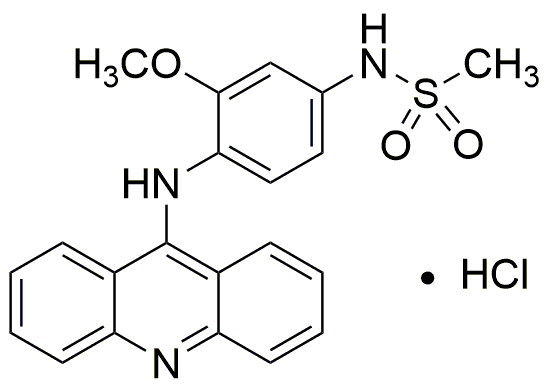Amsacrine hydrochloride is widely utilized in research focused on:
- Cancer Treatment: This compound is primarily used as an antineoplastic agent in chemotherapy, particularly for treating acute leukemia. Its ability to intercalate DNA helps inhibit cancer cell proliferation.
- Pharmaceutical Development: Researchers explore its efficacy in combination therapies, enhancing the effectiveness of other anticancer drugs, which can lead to improved patient outcomes.
- Cellular Mechanism Studies: Amsacrine hydrochloride is valuable in laboratory studies investigating cellular mechanisms of drug resistance, helping scientists understand how cancer cells evade treatment.
- Drug Formulation Research: The compound is used in developing new drug formulations, focusing on improving bioavailability and reducing side effects, which is crucial for patient compliance.
- Biochemical Assays: It serves as a tool in various biochemical assays to study DNA interactions and the effects of DNA damage, providing insights into fundamental biological processes.
General Information
Properties
Safety and Regulations
Applications
Amsacrine hydrochloride is widely utilized in research focused on:
- Cancer Treatment: This compound is primarily used as an antineoplastic agent in chemotherapy, particularly for treating acute leukemia. Its ability to intercalate DNA helps inhibit cancer cell proliferation.
- Pharmaceutical Development: Researchers explore its efficacy in combination therapies, enhancing the effectiveness of other anticancer drugs, which can lead to improved patient outcomes.
- Cellular Mechanism Studies: Amsacrine hydrochloride is valuable in laboratory studies investigating cellular mechanisms of drug resistance, helping scientists understand how cancer cells evade treatment.
- Drug Formulation Research: The compound is used in developing new drug formulations, focusing on improving bioavailability and reducing side effects, which is crucial for patient compliance.
- Biochemical Assays: It serves as a tool in various biochemical assays to study DNA interactions and the effects of DNA damage, providing insights into fundamental biological processes.
Documents
Safety Data Sheets (SDS)
The SDS provides comprehensive safety information on handling, storage, and disposal of the product.
Product Specification (PS)
The PS provides a comprehensive breakdown of the product’s properties, including chemical composition, physical state, purity, and storage requirements. It also details acceptable quality ranges and the product's intended applications.
Certificates of Analysis (COA)
Search for Certificates of Analysis (COA) by entering the products Lot Number. Lot and Batch Numbers can be found on a product’s label following the words ‘Lot’ or ‘Batch’.
*Catalog Number
*Lot Number
Certificates Of Origin (COO)
This COO confirms the country where the product was manufactured, and also details the materials and components used in it and whether it is derived from natural, synthetic, or other specific sources. This certificate may be required for customs, trade, and regulatory compliance.
*Catalog Number
*Lot Number
Safety Data Sheets (SDS)
The SDS provides comprehensive safety information on handling, storage, and disposal of the product.
DownloadProduct Specification (PS)
The PS provides a comprehensive breakdown of the product’s properties, including chemical composition, physical state, purity, and storage requirements. It also details acceptable quality ranges and the product's intended applications.
DownloadCertificates of Analysis (COA)
Search for Certificates of Analysis (COA) by entering the products Lot Number. Lot and Batch Numbers can be found on a product’s label following the words ‘Lot’ or ‘Batch’.
*Catalog Number
*Lot Number
Certificates Of Origin (COO)
This COO confirms the country where the product was manufactured, and also details the materials and components used in it and whether it is derived from natural, synthetic, or other specific sources. This certificate may be required for customs, trade, and regulatory compliance.


